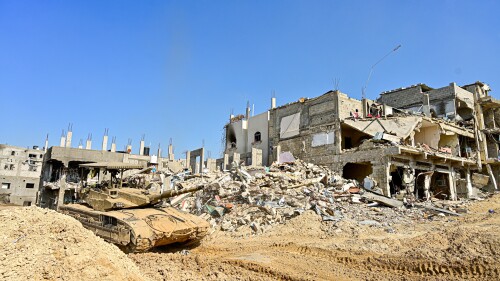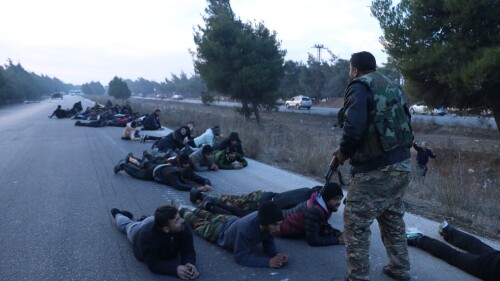Protests sparked by government mismanagement of water resources have spread throughout much of Iran. |
Iran is currently experiencing a significant wave of unrest. Protests began on July 15 in the southwestern Khuzestan Province. The initial focus was a scarcity of water in recent months, which has led to deaths among livestock and consequent impoverishment among farmers in the ethnically diverse province. The lack of water is also leading to a breakdown in electricity provision and frequent blackouts.
But while scarcity of water was the initial trigger, the protests soon began to include more generalized slogans against the ruling Islamist regime. Khuzestan Province, in which Arab-Iranians form the largest community, is a place of high unemployment, poorly served by the central government in terms of services. In the course of a week, the protests spread, with additional, though smaller, demonstrations taking place in the cities of Isfahan, Karaj, Kermanshah and Tabriz.
Triggered by water scarcity, the protests soon began to include more generalized anti-regime slogans.
On July 26, the unrest reached the Iranian capital. Videos and reports from the Tehran protests show demonstrators chanting against the regime. Slogans including “Death to the dictator,” “Khamenei, shame on you – leave Iran alone” and, notably, “No Gaza, no Lebanon, my life for Iran.” The latter chant, heard also in the widespread unrest that hit Iran in late 2019, reflects the widespread perception among Iranians that their country’s resources are being wasted on support for Islamic causes across the region, leading to international sanctions and leaving little available for Iran’s own population.
Notably, protesters also chanted slogans in favor of Reza Shah, the military officer who founded the Pahlavi dynasty in the early part of the 20th century, and who is remembered as a modernizing force by many Iranians.
The authorities have reacted to the protests with predictable harshness.
The authorities have reacted to the protests with predictable harshness. In a repeat of what took place in late 2019, Internet reception has been blocked in Khuzestan. Activists in Iran are deeply concerned at what they describe as regime efforts to build a “national Internet” system along Chinese lines, (and, some maintain, with Chinese assistance). Such a system would severely curtail the ability of Iranian citizens to communicate with one another and to access online sources not approved by the regime.
Riot police and Revolutionary Guards personnel have been rushed to restive areas. Ten people so far are reported to have been killed. As of the beginning of this week, according to Amnesty International, the authorities commenced the use of live fire against protesters. In the nationwide protests of late 2019, more than 1,500 people were killed. The death toll in the current protests looks set to rise sharply.
The blocking of Internet provision to areas affected by unrest has two purposes: firstly, it prevents or complicates communication between protesters, who rely on online channels to spread the word concerning protests, in particular in keeping other parts of the country informed of events and seeking to broaden unrest (other means are available for communication and propaganda on a more local level). Secondly, Internet restrictions prevent protesters from keeping international audiences from seeing their videos and messages.
So what has precipitated the current wave of unrest? And is there reason to believe that this round of protests may differ from previous periods of discontent, and may succeed in posing the question of the continued existence of the clerical regime in Iran?
Regarding the first question, as with previous waves of protest in Iran and elsewhere, a cluster of causes may be identified. Since last year, Khuzestan has been affected by a severe drought. According to Iran’s meteorological service, the months from October 2020 to June 2021 were the driest for the last 53 years. The Karun River, which flows through Khuzestan, has now entirely dried up.
But the water shortages in Khuzestan and elsewhere in Iran are not solely the product of climatic conditions. These have been exacerbated by policies deemed necessary because of the broader regime strategy of confrontation with the West and its regional allies.
Like past regimes that sought to challenge the core rules of the international system, the Iranian government seeks to secure for itself as far as is possible independent sources of food provision. This has led to an emphasis on the development of agriculture within Iran. This in turn has led to an overexploitation of water resources, which is now producing negative results. Around 90% of Iran’s total water consumption is used by the agricultural sector. The main crops grown in Khuzestan are rice and sugarcane, both of which require large amounts of water.
Overexploitation of water resources for a period of decades took place in the absence of a coherent national strategy for the husbanding of water. The result is now becoming apparent in the growing salinity and in places aridity of considerable parts of Iran’s south. This is bringing water shortages to the population, and raises the possibility of large-scale movements of population. Over-damming of water resources, which leads to the drying up of reservoirs, is exacerbating the issue.
Drought, exacerbated by clumsy and unsuccessful state policy, has played a role in the fomenting of unrest and instability elsewhere in the Middle East. In Syria, for example, a severe drought combined with the effect of economic mismanagement led to the departure of 1.5 million farmers from their lands in the pre-2011 period. The result was the emergence of a class of displaced, poor, Sunni Arab families in and around Damascus and other major cities. The insurgency that began in Syria in late 2011 found its most willing foot soldiers from among this sector.
So might the current drought-inspired unrest in Iran produce a similar result?
While nothing should be ruled out, the current situation is still very far from there. The protests underway are considerably smaller than those witnessed in 2019. There is still, crucially, a lack of any kind of credible revolutionary leadership able to pose a popular alternative to the rule of the clerics and the IRGC.
But for all that, according to one Iranian source, the current protests do have real significance. This source notes that the water and electricity shortages are without precedent, and are serving to turn popular sentiment away from further thoughts of reform, and toward a wholesale rejection of the current regime. If such a thorough rejection of the system itself is indeed spreading among the public, it may well bring further results over time.
Certainly the current events in Iran are yet more proof that the Achilles’ heel of the Iranian system is its inability to create workable conditions of social and economic life for the populations who live under its control.
This inability, in time, may well prove fatal to the regime. For the moment, the unrest, and the crackdown, are continuing.
Jonathan Spyer is a Ginsburg/Milstein Writing Fellow at the Middle East Forum and director of the Middle East Center for Reporting and Analysis.









